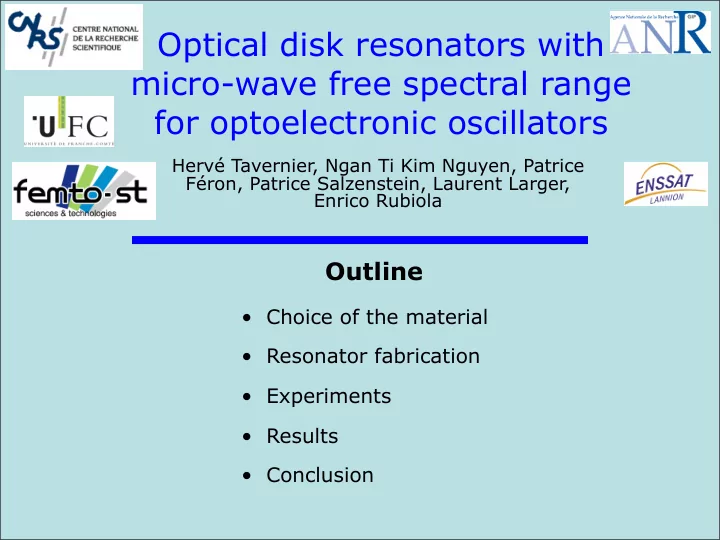

Optical disk resonators with micro-wave free spectral range for optoelectronic oscillators Hervé Tavernier, Ngan Ti Kim Nguyen, Patrice Féron, Patrice Salzenstein, Laurent Larger, Enrico Rubiola Outline • Choice of the material • Resonator fabrication • Experiments • Results • Conclusion
Optical materials • Q = 6 x 10 10 demonstrated with CaF 2 disk (I. Grudinin). MgF2 CaF2 Fused silica Quartz 0.12 to 8.5 0.18 to 2.5 0.19 to 2.9 Transparency 0.2 to 9 µ m µ m µ m µ m range Refractive no = 1.37 no = 1.54 index @ 1550 n = 1.42 n = 1.44 ne = 1.38 ne = 1.53 nm Hardness 6 4 6-7 7 (Mohs) Crystal Class Tetragonal Cubic noncrystalline Hexagonal H2O pollution Good Good Bad Bad Mechanical Good Bad Good good shock I. S. Grudinin, V. S. Ilchenko, and L. Maleki, Phys. Rev. A 74, 063806(9) (2006). 2
3 MgF2 inversion point relates to Pound stabilization
Dedicated lathe air air air air • Brushless motor. air air • Air-bearing to guarantee low vibrations. Text • Small eccentricity error (200 nm). • Precision collet to position the resonator holder. Derives from hard-disk test equipment Can you figure out what a hard disk is? 3.5” & 7200 rpm => ~ 200 km/h 1 ( μ m) 2 bit area, 50 nm head–disk distance 3
Resonators preforming • Stick a 6 mm MgF2 optical window on a metal holder (0.5 - 1 mm thick). • Correct for the centering error by grinding with several diamond grains size (40 - 20 µ m). • Create two 20° bevels to get a thin edge (about 30 µ m, depending on crystal splinters). 4
Manual polishing step • Several polishing powders in decreasing grains size (diamond, colloidal silica , cerium oxide, alumina) diluted in distilled water (6 µ m to 30 nm). • Polishing baize used as powder holder. • Rotation speed depends on grain size. 5
Newton rings • White light phase-shifting microscope 200 nm surface roughness with 1 nm of resolution. (FEMTO-ST instrument, based on the idea of phase-contrast microscope) • Interference fringes as contour curves. < 20 nm surface roughness Smooth contour curves indicates roughness less than 20 nm. 6
Roughness measurement White light phase-shifting microscope with piezo control, after scan and image processing 3D surface of the disk Roughness: 6 nm peak-to-peak, 0.92 nm rms. 7
Taper coupling Taper glued on the holder • Tapered SMF28 fiber glued on the holder. Manufactured by LASEO (Lannion, FR) • For lowest stress, holder geometry and alloy match the Nano-positioning system thermal expansion of glass. • Waist < 3 µ m. • 3-axis nano-positioning with 20 nm resolution. Advantages vs. prism-shaped fiber: + higher modal selectivity + clean mechanical design + one coupler serves as in/out 8
Resonance measurement • 1550 nm erbium laser (3 mW power). • 50 pm wavelength sweep (6 GHz) . • High resolution oscilloscope to analyze very sharp Tunics @ 1550 nm phenomena as peak resonance. 9
Detection of the resonance peak • Single mode excitation: • Small taper size selects a thin excitation region. • Needs polarization Same peak controller. • Wavelength span too small to scan a full FSR. • Scan rate 50 Hz 10
Q factor measurement • Self-homodyne method. • Increasing wavelength triangle scan. • 400 Hz scan rate. • Oscillation damping gives: Q=3.4 x 10^8 J. Poirson, F. Bretenaker, M. Vallet, and A. Le Floch, J. Opt. Soc. Am. B 11, 2811 (1997). 11
Thermal effect • Asymmetric shape. • Positive TC ( λ ) of the resonance. • Triangle sweep. • First half of resonance shape: the carrier increasingly heats the energy region. The resonance tracks the carrier. • Second half: heating decreases. The resonance steps back 12
Thermal effects example of CaF2 resonator 5.5 mm • cross section of the field region 1 μ m 2 • CaF 2 thermal conductivity 9.5 W/mK • dissipated power 300 μ W 8 mm • wavelength 1.56 μ m CaF 2 optical • air temperature 300 K resonator • still air thermal conductivity 10 W/m 2 K • simplification: the heat flows from the mode region is uniform bottom plane at a reference temperature inner bore at a reference temperature finite-element simulation and data refer to another resonator 13 because with a single taper we can ’ t measure the resonator dissipated power
Thermal effects : CaF2 example thermal expansion yields a frequency change ∆ ν dL L dT ∆ T ≃ ν 0 the thermal expansion coefficient of CaF 2 is dL L dT ≃ 1 . 85 × 10 − 5 take a frequency change of 1.13 MHz at 192 THz (1560 nm) ∆ T ≃ 3 . 2 × 10 − 4 K A factor 10 is missing, vs. finite-element calculus. Of course, the mode ring is constrained by the cold crystal around. High temperature gradient 14
Conclusion • Design and implementation of a dedicated lathe with 200 nm eccentricity error and low vibrations. • A few 5.5 mm MgF2 resonator implemented. • Preforming and polishing process gives surface roughness of 0.92 nm rms on the 60 µ m polished edge. • First demonstration of the microwave-FSR resonator with taper coupling. • Stable coupling over > 1 week. • Preliminary result: Q = 3.4 x 10^8. Thanks to L.Maleki, N.Yu, I.Grudinin, V.Ilchenko, A.Savchenkov (JPL/OEwaves) for numerous discussions Grants from ANR and CNES 15
Recommend
More recommend